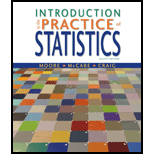
(a)
To graph: A diagram with the use of confidence interval applet.
(a)
Explanation of Solution
Calculation: To construct confidence inetrvals, use confidence interval applet. The following steps are provided below:
Step 1: Go to the “Confidence interval applets” in the website. The screenshot is
shown below:
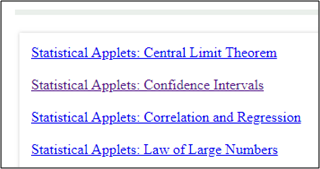
Step 2: Specify confidence interval as “80” and specify the
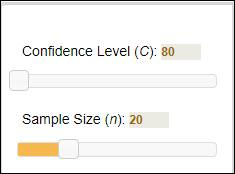
Step 3: Click on the “Sample 25” to generate the sample. The screenshot is shown below:
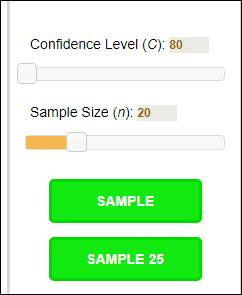
Graph: The obtained output is shown below:
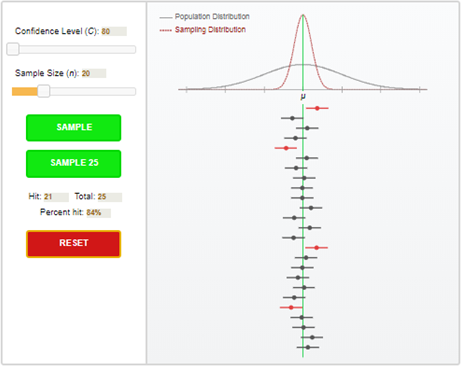
From the above srceenshot, intervals that contain the true
Interpretation: From the above output, out of a total 25, 21 intervals contain the true mean and the proportion of the interval that contains true mean is 84%.
(b)
To find: The confidence interval with 50 SRSs.
(b)
Answer to Problem 5UYK
Solution: The confidence interval with 50 SRSs is shown below:
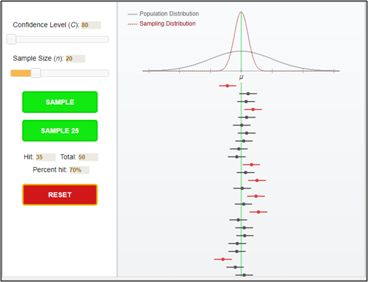
Explanation of Solution
Calculation: To construct confidence intervals, use confidence interval applet. The following steps are provided below:
Step 1: Go to the “Confidence interval applets” in the website. The screenshot is shown below:

Step 2: Specify confidence interval as “80” and specify the sample size as “20.” The screenshot is shown below:
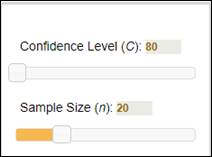
Step 3: Click twice on the “Sample 25” to generate the sample. The screenshot is shown below:
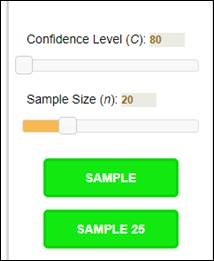
The obtained output is shown below:
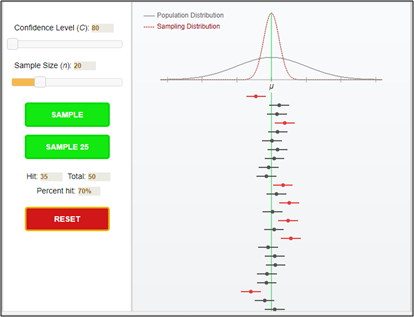
From the above sceenshort, intervals that contain the true mean
Interpretation: The above figure indicates the hit 35, total 50, and percent hit 70%. Thirty-five out of 50 intervals contain the true mean and the proportion of the interval that contains the true mean is 70%.
To find: The confidence interval with 100 SRSs.
Answer to Problem 5UYK
Solution: The confidence interval with 100 SRSs is shown below:
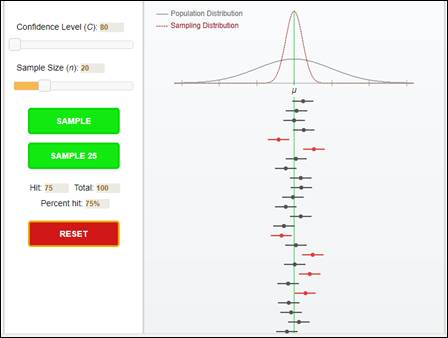
Explanation of Solution
Calculation: To construct confidence inetrvals, use confidence interval applet. The following steps are provided below:
Step 1: Go to the “Confidence interval applets” in the website. The screenshot is shown below:

Step 2: Specify confidence interval as “80” and specify the sample size as “20.” The screenshot is shown below:

Step 3: Click four times on the “Sample 25” to generate the sample. The screenshot is shown below:

The obtained output is shown below:
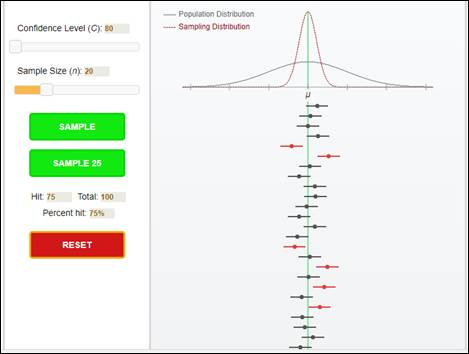
From the above sceenshort, intervals that contain the true mean
Interpretation: The above figure indicates the hit 75, total 100, and percent hit 75%. Seventy-five out of 100 intervals contain the true mean and the proportion of the interval that contains the true mean is 75%.
To find: The confidence interval with 200 SRSs.
Answer to Problem 5UYK
Solution: The confidence interval with 200 SRSs is shown below:
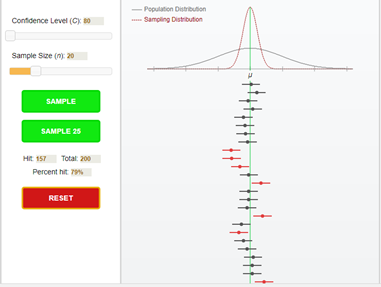
Explanation of Solution
Calculation: To construct confidence inetrvals, use confidence interval applet. The following steps are provided below:
Step 1: Go to the “Confidence interval applets” in the website. The screenshot is shown below:
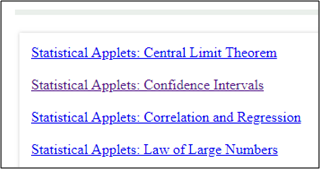
Step 2: Specify confidence interval as “80” and specify the sample size as “20.” The screenshot is shown below:

Step 3: Click eight times on the “Sample 25” to generate the sample. The screenshot is shown below:

The obtained output is shown below:
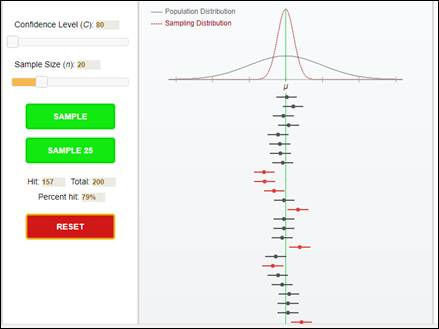
From the above sceenshort, intervals that contain the true mean
Interpretation: The above figure indicates the hit 157, total 200, and percent hit 79%. One hundred and fifty-seven out of 200 intervals contain the true mean and the proportion of the interval that contains the true mean is 79%.
To find: The confidence interval with 300 SRSs.
Answer to Problem 5UYK
Solution: The confidence interval with 300 SRSs is shown below:
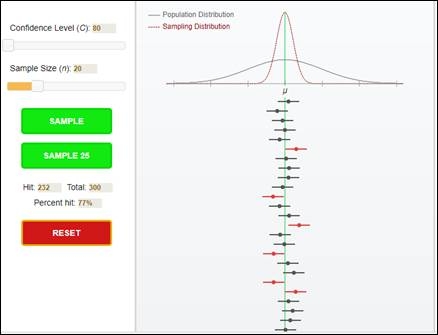
Explanation of Solution
Calculation: To construct confidence inetrvals, use confidence interval applet. The following steps are provided below:
Step 1: Go to the “Confidence interval applets” in the website. The screenshot is shown below:

Step 2: Specify confidence interval as “80” and specify the sample size as “20.” The screenshot is shown below:

Step 3: Click 12 times on the “Sample 25” to generate the sample. The screenshot is shown below:

The obtained output is shown below:
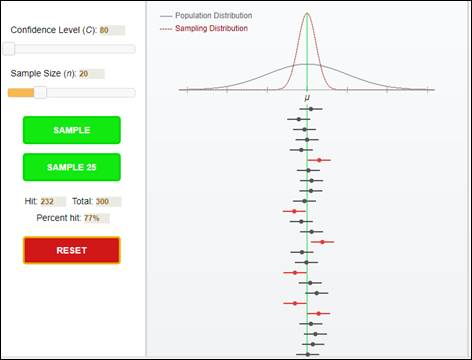
From the above sceenshort, intervals that contain the true mean
Interpretation: The above figure indicates the hit 232, total 300, and percent hit 77%. Two hundred and thirty-two out of 300 intervals contain the true mean and the proportion of the interval that contains the true mean is 77%.
To find: The confidence interval with 400 SRSs.
Answer to Problem 5UYK
Solution: The confidence interval with 400 SRSs is shown below:
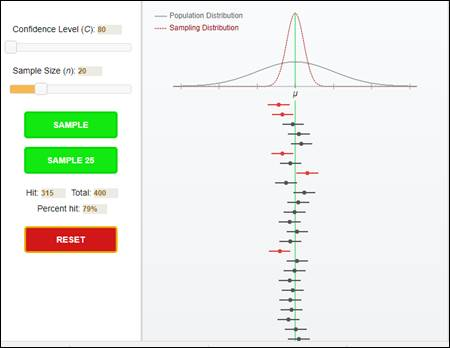
Explanation of Solution
Calculation: To construct confidence inetrvals, use confidence interval applet. The following steps are provided below:
Step 1: Go to the “Confidence interval applets” in the website. The screenshot is shown below:
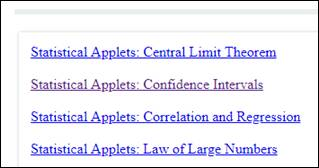
Step 2: Specify confidence interval as “80” and specify the sample size as “20.” The screenshot is shown below:

Step 3: Click 16 times on the “Sample 25” to generate the sample. The screenshot is shown below:

The obtained output is shown below:
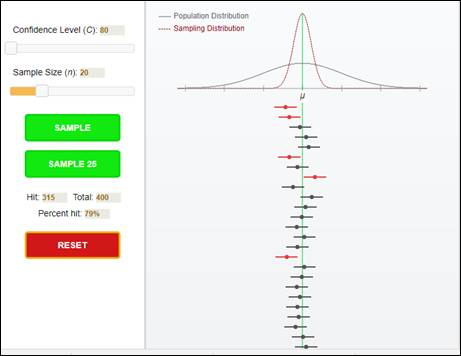
From the above sceenshort, intervals that contain the true mean
Interpretation: The above figure indicates the hit 315, total 400, and percent hit 79%. Three hundred and fifteen out of 400 intervals contain the true mean and the proportion of the interval that contains the true mean is 79%.
To find: The confidence interval with 500 SRSs.
Answer to Problem 5UYK
Solution: The confidence interval with 500 SRSs is shown below:
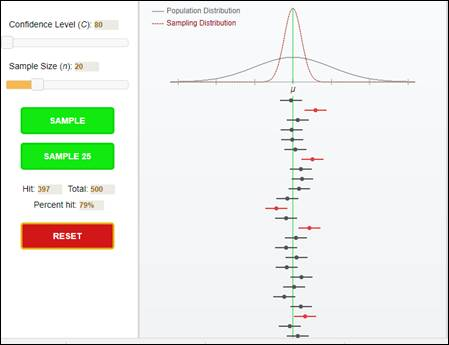
Explanation of Solution
Calculation: To construct confidence inetrvals, use confidence interval applet. The following steps are provided below:
Step 1: Go to the “Confidence interval applets” in the website. The screenshot is shown below:

Step 2: Specify confidence interval as “80” and specify the sample size as “20.” The screenshot is shown below:

Step 3: Click 20 on the “Sample 25” to generate the sample. The screenshot is shown below:

The obtained output is shown below:
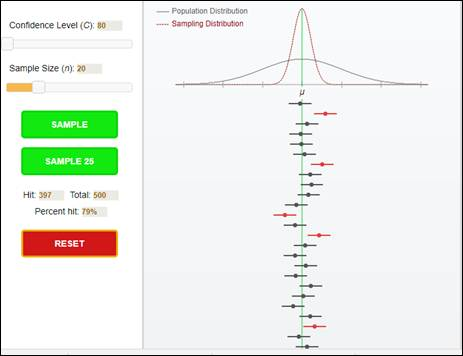
From the above sceenshort, intervals that contain the true mean
Interpretation: The above figure indicates the hit 397, total 500, and percent hit 79%. Three hundred and ninety-seven out of 500 intervals contain the true mean and the proportion of the interval that contains the true mean is 79%. From the pattern in the above seven cases, the proportion hit approaches near by 80% as the number of sample increases. Thus, one should expect that the percent capture to get closer to the confidence interval level is 80% as the number of samples increases.
Want to see more full solutions like this?
Chapter 6 Solutions
Introduction to the Practice of Statistics: w/CrunchIt/EESEE Access Card
- You have been hired as an intern to run analyses on the data and report the results back to Sarah; the five questions that Sarah needs you to address are given below. please do it step by step on excel Does there appear to be a positive or negative relationship between price and screen size? Use a scatter plot to examine the relationship. Determine and interpret the correlation coefficient between the two variables. In your interpretation, discuss the direction of the relationship (positive, negative, or zero relationship). Also discuss the strength of the relationship. Estimate the relationship between screen size and price using a simple linear regression model and interpret the estimated coefficients. (In your interpretation, tell the dollar amount by which price will change for each unit of increase in screen size). Include the manufacturer dummy variable (Samsung=1, 0 otherwise) and estimate the relationship between screen size, price and manufacturer dummy as a multiple…arrow_forwardHere is data with as the response variable. x y54.4 19.124.9 99.334.5 9.476.6 0.359.4 4.554.4 0.139.2 56.354 15.773.8 9-156.1 319.2Make a scatter plot of this data. Which point is an outlier? Enter as an ordered pair, e.g., (x,y). (x,y)= Find the regression equation for the data set without the outlier. Enter the equation of the form mx+b rounded to three decimal places. y_wo= Find the regression equation for the data set with the outlier. Enter the equation of the form mx+b rounded to three decimal places. y_w=arrow_forwardYou have been hired as an intern to run analyses on the data and report the results back to Sarah; the five questions that Sarah needs you to address are given below. please do it step by step Does there appear to be a positive or negative relationship between price and screen size? Use a scatter plot to examine the relationship. Determine and interpret the correlation coefficient between the two variables. In your interpretation, discuss the direction of the relationship (positive, negative, or zero relationship). Also discuss the strength of the relationship. Estimate the relationship between screen size and price using a simple linear regression model and interpret the estimated coefficients. (In your interpretation, tell the dollar amount by which price will change for each unit of increase in screen size). Include the manufacturer dummy variable (Samsung=1, 0 otherwise) and estimate the relationship between screen size, price and manufacturer dummy as a multiple linear…arrow_forward
- Exercises: Find all the whole number solutions of the congruence equation. 1. 3x 8 mod 11 2. 2x+3= 8 mod 12 3. 3x+12= 7 mod 10 4. 4x+6= 5 mod 8 5. 5x+3= 8 mod 12arrow_forwardScenario Sales of products by color follow a peculiar, but predictable, pattern that determines how many units will sell in any given year. This pattern is shown below Product Color 1995 1996 1997 Red 28 42 21 1998 23 1999 29 2000 2001 2002 Unit Sales 2003 2004 15 8 4 2 1 2005 2006 discontinued Green 26 39 20 22 28 14 7 4 2 White 43 65 33 36 45 23 12 Brown 58 87 44 48 60 Yellow 37 56 28 31 Black 28 42 21 Orange 19 29 Purple Total 28 42 21 49 68 78 95 123 176 181 164 127 24 179 Questions A) Which color will sell the most units in 2007? B) Which color will sell the most units combined in the 2007 to 2009 period? Please show all your analysis, leave formulas in cells, and specify any assumptions you make.arrow_forwardOne hundred students were surveyed about their preference between dogs and cats. The following two-way table displays data for the sample of students who responded to the survey. Preference Male Female TOTAL Prefers dogs \[36\] \[20\] \[56\] Prefers cats \[10\] \[26\] \[36\] No preference \[2\] \[6\] \[8\] TOTAL \[48\] \[52\] \[100\] problem 1 Find the probability that a randomly selected student prefers dogs.Enter your answer as a fraction or decimal. \[P\left(\text{prefers dogs}\right)=\] Incorrect Check Hide explanation Preference Male Female TOTAL Prefers dogs \[\blueD{36}\] \[\blueD{20}\] \[\blueE{56}\] Prefers cats \[10\] \[26\] \[36\] No preference \[2\] \[6\] \[8\] TOTAL \[48\] \[52\] \[100\] There were \[\blueE{56}\] students in the sample who preferred dogs out of \[100\] total students.arrow_forward
- Business discussarrow_forwardYou have been hired as an intern to run analyses on the data and report the results back to Sarah; the five questions that Sarah needs you to address are given below. Does there appear to be a positive or negative relationship between price and screen size? Use a scatter plot to examine the relationship. Determine and interpret the correlation coefficient between the two variables. In your interpretation, discuss the direction of the relationship (positive, negative, or zero relationship). Also discuss the strength of the relationship. Estimate the relationship between screen size and price using a simple linear regression model and interpret the estimated coefficients. (In your interpretation, tell the dollar amount by which price will change for each unit of increase in screen size). Include the manufacturer dummy variable (Samsung=1, 0 otherwise) and estimate the relationship between screen size, price and manufacturer dummy as a multiple linear regression model. Interpret the…arrow_forwardDoes there appear to be a positive or negative relationship between price and screen size? Use a scatter plot to examine the relationship. How to take snapshots: if you use a MacBook, press Command+ Shift+4 to take snapshots. If you are using Windows, use the Snipping Tool to take snapshots. Question 1: Determine and interpret the correlation coefficient between the two variables. In your interpretation, discuss the direction of the relationship (positive, negative, or zero relationship). Also discuss the strength of the relationship. Value of correlation coefficient: Direction of the relationship (positive, negative, or zero relationship): Strength of the relationship (strong/moderate/weak): Question 2: Estimate the relationship between screen size and price using a simple linear regression model and interpret the estimated coefficients. In your interpretation, tell the dollar amount by which price will change for each unit of increase in screen size. (The answer for the…arrow_forward
- In this problem, we consider a Brownian motion (W+) t≥0. We consider a stock model (St)t>0 given (under the measure P) by d.St 0.03 St dt + 0.2 St dwt, with So 2. We assume that the interest rate is r = 0.06. The purpose of this problem is to price an option on this stock (which we name cubic put). This option is European-type, with maturity 3 months (i.e. T = 0.25 years), and payoff given by F = (8-5)+ (a) Write the Stochastic Differential Equation satisfied by (St) under the risk-neutral measure Q. (You don't need to prove it, simply give the answer.) (b) Give the price of a regular European put on (St) with maturity 3 months and strike K = 2. (c) Let X = S. Find the Stochastic Differential Equation satisfied by the process (Xt) under the measure Q. (d) Find an explicit expression for X₁ = S3 under measure Q. (e) Using the results above, find the price of the cubic put option mentioned above. (f) Is the price in (e) the same as in question (b)? (Explain why.)arrow_forwardProblem 4. Margrabe formula and the Greeks (20 pts) In the homework, we determined the Margrabe formula for the price of an option allowing you to swap an x-stock for a y-stock at time T. For stocks with initial values xo, yo, common volatility σ and correlation p, the formula was given by Fo=yo (d+)-x0Þ(d_), where In (±² Ꭲ d+ õ√T and σ = σ√√√2(1 - p). дго (a) We want to determine a "Greek" for ỡ on the option: find a formula for θα (b) Is дго θα positive or negative? (c) We consider a situation in which the correlation p between the two stocks increases: what can you say about the price Fo? (d) Assume that yo< xo and p = 1. What is the price of the option?arrow_forwardWe consider a 4-dimensional stock price model given (under P) by dẴ₁ = µ· Xt dt + йt · ΣdŴt where (W) is an n-dimensional Brownian motion, π = (0.02, 0.01, -0.02, 0.05), 0.2 0 0 0 0.3 0.4 0 0 Σ= -0.1 -4a За 0 0.2 0.4 -0.1 0.2) and a E R. We assume that ☑0 = (1, 1, 1, 1) and that the interest rate on the market is r = 0.02. (a) Give a condition on a that would make stock #3 be the one with largest volatility. (b) Find the diversification coefficient for this portfolio as a function of a. (c) Determine the maximum diversification coefficient d that you could reach by varying the value of a? 2arrow_forward
 MATLAB: An Introduction with ApplicationsStatisticsISBN:9781119256830Author:Amos GilatPublisher:John Wiley & Sons Inc
MATLAB: An Introduction with ApplicationsStatisticsISBN:9781119256830Author:Amos GilatPublisher:John Wiley & Sons Inc Probability and Statistics for Engineering and th...StatisticsISBN:9781305251809Author:Jay L. DevorePublisher:Cengage Learning
Probability and Statistics for Engineering and th...StatisticsISBN:9781305251809Author:Jay L. DevorePublisher:Cengage Learning Statistics for The Behavioral Sciences (MindTap C...StatisticsISBN:9781305504912Author:Frederick J Gravetter, Larry B. WallnauPublisher:Cengage Learning
Statistics for The Behavioral Sciences (MindTap C...StatisticsISBN:9781305504912Author:Frederick J Gravetter, Larry B. WallnauPublisher:Cengage Learning Elementary Statistics: Picturing the World (7th E...StatisticsISBN:9780134683416Author:Ron Larson, Betsy FarberPublisher:PEARSON
Elementary Statistics: Picturing the World (7th E...StatisticsISBN:9780134683416Author:Ron Larson, Betsy FarberPublisher:PEARSON The Basic Practice of StatisticsStatisticsISBN:9781319042578Author:David S. Moore, William I. Notz, Michael A. FlignerPublisher:W. H. Freeman
The Basic Practice of StatisticsStatisticsISBN:9781319042578Author:David S. Moore, William I. Notz, Michael A. FlignerPublisher:W. H. Freeman Introduction to the Practice of StatisticsStatisticsISBN:9781319013387Author:David S. Moore, George P. McCabe, Bruce A. CraigPublisher:W. H. Freeman
Introduction to the Practice of StatisticsStatisticsISBN:9781319013387Author:David S. Moore, George P. McCabe, Bruce A. CraigPublisher:W. H. Freeman





